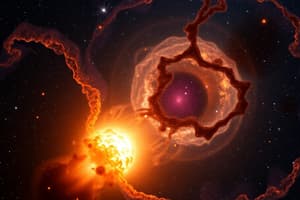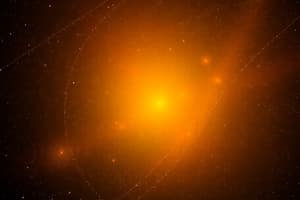Podcast
Questions and Answers
What is nuclear fusion and how does it contribute to the glow of a star?
What is nuclear fusion and how does it contribute to the glow of a star?
Nuclear fusion is the process where two light atomic nuclei combine to form a heavier one, releasing a large amount of heat and light energy. This energy is what causes a star to glow.
What is radiation pressure and how is it generated within a star?
What is radiation pressure and how is it generated within a star?
Radiation pressure is the outward force generated by the heat radiated from nuclear fusion in the core of a star. It pushes against the gravitational collapse, maintaining the star's equilibrium.
What are nebulae and what are they composed of?
What are nebulae and what are they composed of?
Nebulae are interstellar clouds of dust and gas. They are composed of various elements and molecules, including hydrogen, helium, and heavier elements.
Describe the process of star formation and the role of protostars.
Describe the process of star formation and the role of protostars.
Explain the concept of a black hole and its key features.
Explain the concept of a black hole and its key features.
Flashcards are hidden until you start studying
Study Notes
Nuclear Fusion and Stars
- Nuclear fusion occurs when two light nuclei merge to form a heavier one, producing immense heat and light that causes stars to glow.
Pressure and Radiation
- Radiation pressure is an outward force resulting from the heat radiated from nuclear fusion in the core of a star.
Interstellar Clouds and Gas
- Nebulae are interstellar clouds of dust and gas.
- A protostar is a cloud of gas that has clumped together.
Galaxies
- Galaxies are formed by the gravitational attraction between millions of stars, planets, and other interstellar objects.
- The Milky Way is our galaxy, approximately 100,000 light-years across.
- The Andromeda galaxy is the closest galaxy to the Milky Way, approximately 2.537 million light-years away.
Black Holes
- Black holes are regions in space where gravity is so strong that even light cannot escape.
- A singularity is the central point of a black hole where everything is infinitely compressed, and conceptions of time and space break down.
- The event horizon is the 'doorstep' of a black hole, known as the 'point of no return', where anything that crosses it cannot escape.
Measurement
- Parallax is a method used to measure distances in space.
Studying That Suits You
Use AI to generate personalized quizzes and flashcards to suit your learning preferences.




